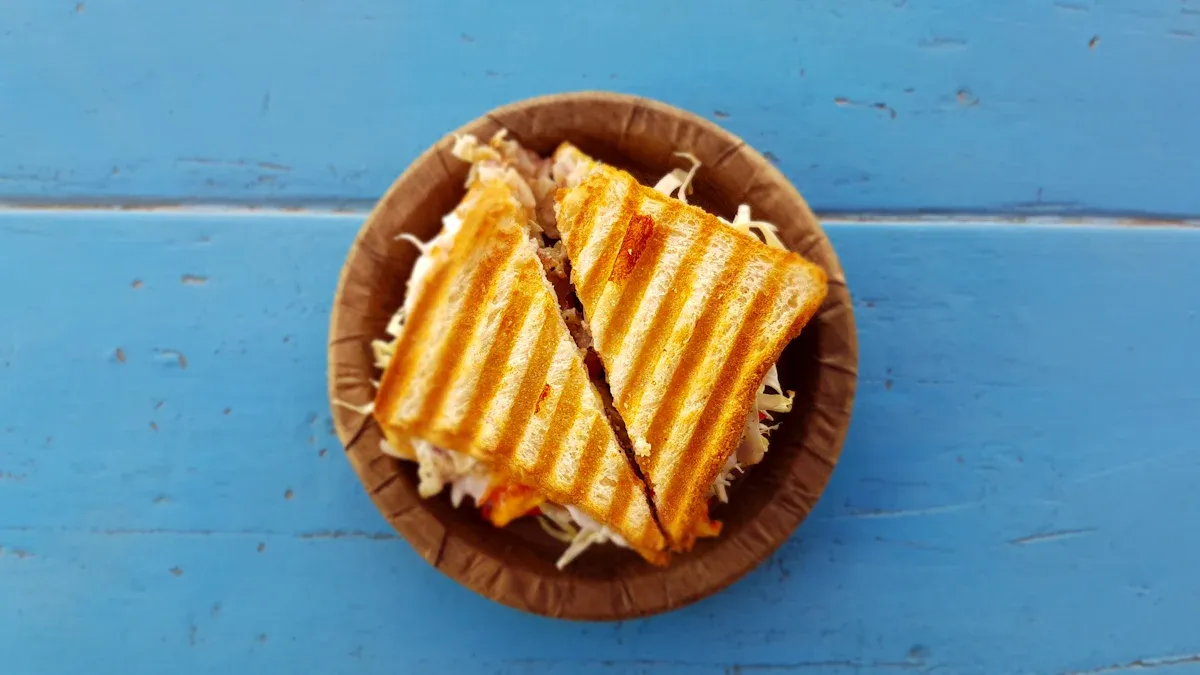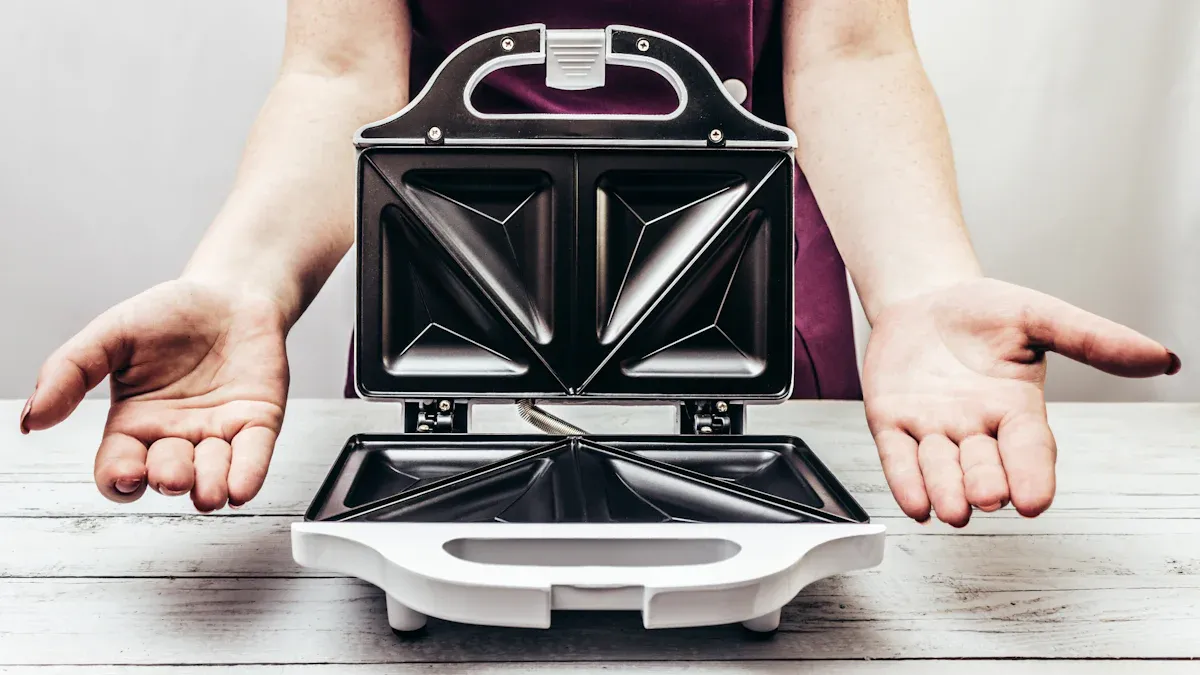
Selecting the right panini press can transform a business. Efficient equipment boosts productivity, reduces costs, and satisfies customers. For example:
- 65% of businesses prioritize efficiency when choosing equipment.
- Over 30% invest in energy-efficient models.
A quality panini press also appeals to health-conscious and design-savvy customers, enhancing their dining experience.
Key Takeaways
- Think about your business needs before picking a panini press. Look at things like your business type, menu choices, and how many customers you serve to find the best one.
- Pick the right plate type for your panini press. Grooved plates make food look nice, while smooth plates work well for soft foods. Combo plates are good for different kinds of menus.
- Take care of your panini press to make it last longer. Clean it after using and season cast iron plates to keep them non-stick.
Understanding Your Business Needs
Choosing the right panini press starts with understanding your business’s unique needs. Whether you run a café, restaurant, or food truck, tailoring your equipment to your operations ensures smooth service and happy customers.
Type of Business: Café, Restaurant, or Food Truck
Different businesses have different requirements. A café might prioritize a compact panini press to save counter space, while a restaurant may need a larger model to handle higher volumes. Food trucks often face space constraints and benefit from lightweight, portable options. Matching the press to your business type ensures it fits seamlessly into your workflow.
Menu Offerings and Sandwich Variety
Your menu plays a big role in selecting the right press. If your offerings include a variety of sandwiches, a combination plate style (grooved and smooth) can provide versatility. Grooved plates create those classic grill marks, while smooth plates are ideal for delicate items like wraps or quesadillas. A versatile panini press can help you deliver consistent quality across your menu.
Customer Demand and Peak Hours
Customer demand determines whether a single or double panini press is the better choice. Single presses work well for low-volume businesses, as they take up less space and cook one item at a time. Double presses, on the other hand, are perfect for busy establishments, allowing two items to cook simultaneously. During peak hours, this can significantly reduce wait times and keep customers satisfied. Additionally, the plate style you choose can impact the food’s appearance, which matters when meeting customer expectations.
Key Features of a Panini Press

Plate Types: Grooved, Smooth, or Combination
The type of plate on a panini press can make a big difference in how your food turns out. Grooved plates create those iconic grill marks, adding a visual appeal to sandwiches. Smooth plates, on the other hand, provide even contact, making them perfect for delicate items like quesadillas. Combination plates offer the best of both worlds, with a grooved top and smooth bottom for versatility. Here’s a quick comparison:
| Plate Type | Features |
|---|---|
| Grooved Top and Bottom | Provides grill lines on the top and bottom of food, Extremely versatile |
| Smooth Top and Bottom | Provides complete contact to cook food evenly, Perfect for grilled cheese and quesadillas |
| Grooved Top/Smooth Bottom | Use bottom plate separately as a griddle, Provides greater versatility |
| Dual Grooved and Smooth | Grooved plates on one side and smooth plates on the other, Ideal for high-volume applications |
Plate Materials: Cast Iron, Aluminum, Non-Stick
The material of the plates affects durability and cooking performance. Cast iron plates are heavy-duty and retain heat well, making them ideal for high-volume use. Aluminum plates, like those in the GreenPan Elite panini press, are lightweight yet tough. They often feature a ceramic non-stick coating, which enhances durability and makes cleaning easier. While some non-stick surfaces struggle with high heat, advanced designs now include features like a "sear" function for high-temperature cooking.
Size and Capacity: Single vs. Dual Presses
The size of your panini press impacts how many sandwiches you can prepare at once. Single presses are compact and great for small businesses. Dual presses, however, double the cooking capacity, making them perfect for busy kitchens. Here’s a comparison of two models:
| Model | Capacity | Power (Watts) | Features |
|---|---|---|---|
| Chefman Multifunctional RJ02-180 | 2 slices | 1000 | 3-in-1 functionality, nonstick coating, floating hinge, indicator lights |
| Cuisinart Griddler GR-4N | 4 slices | 1500 | 5-in-1 functionality, removable plates, dual temperature controls, dishwasher safe |
Temperature Control and Heat Distribution
Temperature control ensures consistent cooking. Without it, food can burn or cook unevenly. For instance, the Chefman Panini Press & Grill lacks adjustable settings, leading to burnt bread before the cheese melts. In contrast, models like the Griddler Elite offer dual temperature modes, allowing for precise cooking. Even heat distribution is equally important. Tools like the Hotplet enhance heat stability, ensuring every sandwich is cooked to perfection.
Durability and Build Quality
A durable panini press withstands daily use without breaking down. Look for models with sturdy materials like cast iron or aluminum. Non-stick coatings should be heavy-duty to resist wear and tear. Investing in a high-quality press reduces long-term costs and ensures reliable performance.
Additional Features: Floating Hinges, Timers, Ergonomic Handles
Extra features can make a panini press more user-friendly. Floating hinges adjust to different food thicknesses, ensuring even cooking. Timers allow multitasking, improving kitchen efficiency. Ergonomic handles reduce strain and make the press easier to use for all staff members. These small details can have a big impact on daily operations.
Maintenance and Cleaning for a Panini Press

Cleaning Tips for Different Plate Types
Keeping your panini press clean ensures better performance and longer life. For grooved plates, use a soft-bristle brush to remove crumbs and grease from the ridges. Smooth plates are easier to clean—just wipe them down with a damp cloth. Non-stick plates require extra care. Avoid abrasive tools that can damage the coating. Instead, use a sponge or a soft cloth with mild soap. Always clean the plates while they’re warm, not hot, to make the process easier and safer.
Seasoning Cast Iron Plates
Seasoning cast iron plates is essential for maintaining their non-stick surface and durability. Here’s why it matters:
- It creates a natural non-stick layer, preventing food from sticking.
- It improves the taste of food by avoiding residue build-up.
- Regular seasoning extends the lifespan of the plates.
To season, apply a thin layer of cooking oil to the plates and heat them until the oil bonds with the surface. Repeat this process periodically to keep the plates in top condition.
Preventing Build-Up and Prolonging Lifespan
Preventing grease and food build-up is key to keeping your panini press in great shape. Wipe down the plates after every use to remove residue. For stubborn spots, use a mixture of water and vinegar. Avoid using metal utensils that can scratch the surface. Regular maintenance not only keeps the press clean but also ensures consistent cooking results and a longer lifespan.
Practical Buying Tips for a Panini Press
Assessing Your Menu and Cooking Needs
Understanding your menu is the first step in choosing the right panini press. A business can analyze sales data, food costs, and customer preferences to identify which menu items are most profitable. For example:
- Tracking sales metrics reveals which sandwiches are customer favorites.
- Analyzing food costs highlights items that may need adjustments.
- Streamlining inventory ensures the panini press supports efficient operations.
By focusing on these factors, businesses can select a press that aligns with their cooking needs and menu variety.
Measuring Counter Space and Kitchen Layout
Before purchasing, measuring available counter space is crucial. A compact press works well for small kitchens, while larger models suit spacious layouts. Food trucks, for instance, benefit from lightweight, portable presses that fit tight spaces. Ensuring the press integrates seamlessly into the kitchen layout prevents workflow disruptions.
Setting a Budget and Comparing Options
Budgeting wisely helps businesses balance cost and quality. Here’s a breakdown of strategies:
| Strategy | Description |
|---|---|
| Price Sensitivity | Refurbished units are popular in regions with high equipment costs. |
| Premium Willingness | ENERGY STAR-certified models save on utilities, despite higher upfront costs. |
| Financing Options | Leasing spreads costs into manageable monthly payments. |
| Energy Rebates | Tax incentives make eco-friendly models more affordable. |
Comparing these options ensures businesses find a press that meets their financial and operational needs.
Reading Reviews and Checking Warranties
Reviews provide valuable insights into a panini press’s performance and durability. Look for feedback on heat distribution, ease of cleaning, and build quality. Checking warranties is equally important. A solid warranty protects against unexpected repairs, offering peace of mind and long-term savings.
Choosing the right panini press can elevate any business. Aligning its features with specific needs ensures efficiency and customer satisfaction. Here’s a quick recap of key features:
| Feature | Benefits | Drawbacks |
|---|---|---|
| Single Panini Press | Compact, saves counter space, ideal for low volume or space-efficient businesses | Limited size, cooks only one type of product at once |
| Dual Panini Press | Can cook different products at once, greater versatility with configurations | Larger units take up more counter space, uses more power |
| Floating Hinge | Adjusts to cook foods of different thicknesses, ensures even cooking | N/A |
| Ergonomic Handles | Enhances safety for all users, meets ADA requirements | N/A |
| Adjustable Thermostats | Allows for cooking at various temperatures, increases versatility | N/A |
| Timers | Improves kitchen efficiency, allows multitasking | N/A |
Maintaining your panini press is just as important. Regular cleaning and proper care extend its lifespan and keep it performing at its best. Businesses benefit from these grills in many ways:
- They expand menu options, attracting diverse customers.
- Their versatility suits restaurants, cafés, and food trucks.
- Grilled sandwiches, like a ham and cheese, can double profits compared to ungrilled versions.
Investing in the right panini press supports long-term success. Make a choice that fits your goals and keeps customers coming back for more!
FAQ
What is the best plate material for a panini press?
Cast iron plates are durable and retain heat well. Aluminum plates heat quickly and are lightweight. Non-stick plates simplify cleaning but may wear out faster.
How often should a panini press be cleaned?
Clean the press after every use. Wipe warm plates with a damp cloth to remove residue. Regular cleaning prevents build-up and ensures consistent cooking performance.
Can a panini press cook more than sandwiches?
Yes! Use it for grilling vegetables, quesadillas, or even breakfast items like pancakes. Its versatility makes it a valuable tool for any kitchen.

